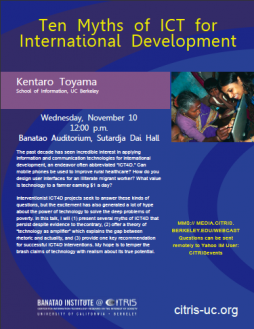Today at noon PST, Kentaro Toyama will give a talk from UC Berkeley on Ten Myths of ICT for International Development, a topic dear to our hearts as we continue to demystify mobile technology for social change.
A live broadcast is available here. Questions can be sent via Yahoo IM to username: citrisevents.
The Center for Information Technology Research in the Interest of Society summarizes the event here:
The past decade has seen incredible interest in applying information and communication technologies for international development, an endeavor often abbreviated "ICT4D." Can mobile phones be used to improve rural healthcare? How do you design user interfaces for an illiterate migrant worker? What value is technology to a farmer earning $1 a day?
Interventionist ICT4D projects seek to answer these kinds of questions, but the excitement has also generated a lot of hype about the power of technology to solve the deep problems of poverty.
Toyomo blogs at ICT4DJ Jester. He notes that in this talk, he
"will (1) present several myths of ICT4D that persist despite evidence to the contrary, (2) offer a theory of "technology as amplifier" which explains the gap between rhetoric and actuality, and (3) provide one key recommendation for successful ICT4D interventions. My hope is to temper the brash claims of technology with realism about its true potential."
For background on the issues he will raise, see his piece in the Boston Review: Can Technology End Poverty. We'll update this post after the talk!
Update: In his talk, Toyomo presented five myths that persist despite evidence to the contrary.
- Technology counteracts the phenomenon of the rich getting richer.
- Information is the bottleneck.
- Needs are more pressing than desires.
- Technology’s impact is necessarily postitive.
- Technology will save the world.
Toyomo also offered a theory of "technology as amplifier" in that technology is a magnifier of human and institutional intent and capacity. This, he said, explains the gap between rhetoric and actuality.
Finally, Toyomo offered a key recommendation for people who are doing projects with technology: Make sure you look for institutions that are already accomplishing the positive development impact that you want, and see if you can use technology to help those organizations rather than rushing in headlong with the technology itself.
For more, check out the video on YouTube.


Well, amen to all that!
Yes, all true - that is, these myths are most certainly mythical, if that is the right way of putting it. Still, who actually works at this level? Perhaps at the UN there is a need to consider such considerations at such a level of reification. (But the UN is so etherial that mythical or not doesn't make much difference, no?) Down here, however, the issue isn't saving the world; the issue is finding ways to improve health outcomes. It is, for example, finding a way to improve patient adherence to high blood pressure meds regimes when the patient can't afford to come to the clinic and the clinic can't afford to go to the patient. It won't save the world, but just like my mom's asking "did you take your vitamins?" did get me to take my vitamins, it is amazing how effective a push text can be. "Did you take your high blood pressure meds today?" Whether reducing blood preassure and so CVD's leading role in our mortality statistics is development is a philosophical question. (After all, as my brother the doc notes, in the end we are all dead.) But for those of us who keep our noses very close to the ground and keep our criteria for success equally limited, prolonging meaningful life by reducing the rate of strokes, for example, is a good thing - and simple mobile applications have made this much easier than it used to be.
Michael Shafer Warm Heart Foundation Phrao, Chiang Mai, Thailand
Post new comment